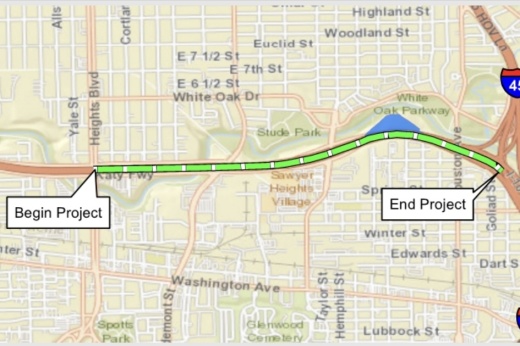The state- and federally funded project would stretch about 1.8 miles from Heights Boulevard to I-45, TxDOT Public Information Officer Deidrea George told Community Impact Newspaper.
The proposed typical section of the project will consist of the same number of lanes as what is already in place but at an elevated level—five 12-foot-wide lanes in each direction, a 10-foot-wide inside lane and outside shoulders, and one 14-foot-wide high-occupancy vehicle lane in each direction.
Community Impact Newspaper has reached out to TxDOT for the proposed elevation heights.
According to TxDOT documents, a 21.7-acre detention pond will be located under the elevated area on the north side of I-10 between Taylor Street and Houston Avenue along with a 10-foot-wide shared-use path for pedestrians and cyclists that will connect to the existing trail system on the north side of I-10 along White Oak Bayou between Studemont Street and I-45.
According to TxDOT’s presentation, the proposed elevated area has repeatedly been affected by major rain events, such as tropical storms Allison and Imelda and Hurricane Harvey. Once flooded from White Oak Bayou, the main lanes become impassable.
In an interview with Community Impact Newspaper, Kevin Strickland with CURBS Houston—a community group of Heights residents seeking to create a safer neighborhood—said he has concerns about TxDOT's efforts to keep I-10 from flooding at that point. He said I-10 becoming a “lake” during Hurricane Harvey saved area neighborhoods from flooding.
“[The project] doesn’t make sense,” Strickland said. “It’s completely unnecessary.”
Strickland also said TxDOT’s proposal is slowing down the METRORapid University Corridor project—a rapid bus transit line that is projected to run from Westchase Park & Ride to Tidwell Transit Center. However, George said TxDOT is doing its due diligence through collaborative partnerships with other entities.
In an interview with Community Impact Newspaper, resident Matt Tetlow said he does not support the project. Along the Washington Avenue corridor, where Tetlow said he lives, there are already issues with noise from roads and traffic, he said. With this project, he said he thinks the problem will worsen.
“There's a lot of noise impacts that really hurt people who live where I live,” Tetlow said. “I'd like to see us do something smarter. ... This is an organization that is a hammer, and everything looks like a nail—build it wider, bigger, taller, right? I'd like to see them take more local input to find win-win projects.”
George said TxDOT is open to public feedback, and those who would like to give input can do so until Aug. 12.
Once the public comment period ends, the project will go through a series of phases. From this fall through fall 2023, environmental documents and a detailed schematic design will be developed. In winter 2023, an environmental decision will be made, and in summer 2024, construction is anticipated to begin.
“This is why we're here," George said. "We certainly are taking all of [the concerns] into account.”





